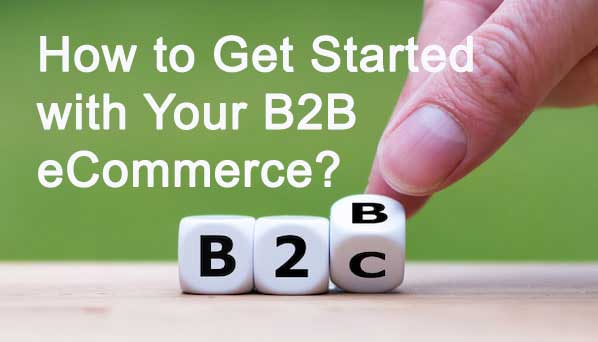Let us admit. We’ve all been guilty of it – whether at home or the office. We all want to dive into a new project as fast as possible. “Forget about planning, let’s just start – When is the Launch Date!” These are always exciting and nerve-wracking times. Don’t you agree? If you are the one scheduling the internal kickoff, those meetings will always be the best attended (maybe besides “Design Reveal Day”). But how should you kick off a B2B eCommerce project the right way to have the best chances of success? Here are a few practical steps to follow.
Defining Your Goals
A great start would be to plan out and set some goals before starting anything. If you have been following our blogs, In our previous articles, we discussed digital transformation. We outlined the reasons why Today is the time to start a B2B eCommerce transformation project. But which reason of those resonates with you and your team the most? Here are our two cents. It can not be everything.
Let us think about it. If you are like many business stakeholders, don’t have infinite time, resources, or even enough budget to tackle your wish list. Then, let us agree, driving conversations with an internal team to review their needs and priorities is going to be the most important goal.

Setting Your Goals
Your first question to ask should be. What does my company need to improve? What are our main targets to achieve? It is recommended to start with a high-level goal like: “We want to sell online.” “We want to launch a customer portal”; or “Our product catalog is incomplete.” And then narrow down the focus to more specifics. For example, you can work on what it really means “We want to sell online”?
The goals don’t necessarily need to be directly tied to a project but could also be project supported. For example, improving site traffic through SEO might not be possible right now due to a poor storefront. But could be improved with a build related to the digital commerce initiative.
Next, what are other goals to set? It doesn’t have to be Sales or Revenue, surprising, right? In fact, the purpose behind the transformation you’re targeting could be as simple as “building efficiency”. Also, “enablement of the existing sales team”. If there are challenges you can solve quickly and easily, especially with customer experience. That reduces churn, drives more reorders, or saves customer service expenses, those might take priority.
Build Your Internal Team
No doubt, getting your internal team and key business stakeholders on the same page is challenging. But, by all means, the exercise is worth it in the end. Start by deciding “who” of the key business stakeholders to be on the list. Most likely you will need to include the leadership team and other roles that are directly interacting with your customer like your marketing, or sales team members.
After reviewing the priorities of your internal team and what they identified as most important to start with. Set your long and short-term action lists. A short-term list could be “list what going to do Now.” A Long-term list of “List what you are going to do Later”. We can not stress more that “Openness and Clarity” are key to the process of building your timeline, budget, and engineering. Plus, keep your team informed as those lists keep changing in priorities or budgets.
Set Your Budgets & Timeline
To be realistic, nothing can hinder you from achieving your goals and delivering your business solution like running out of budget or lacking financial resources, or failing to launch. No doubt, being realistic about your resources and timeline required is key to getting there. It is crucial to setting expectations internally.
What To Include while Building Your Budget: Here are a few tips. Leaning on your previous budget-building experience, and asking tough questions like “how much do I have to spend” as a high-level number is likely to provide a strong guideline internally, and with your vendor selection process.
Setting a budget for an eCommerce project requires careful consideration of many factors. The budget should reflect the goals and objectives of the project, and should also take into account resources such as personnel, materials, and technology. A budget should also include a contingency plan in case of unexpected expenses or delays.
Creating A Timeline Framework – Going hand-in-hand with the budget is a timeline framework. Defining a timeline will require input and scheduling from any vendor or external team. But the first question they ask “when do you want to go live?” Working with the rest of the team to define any critical milestones, business events, or plans that have an impact on your target.
Here are some other considerations to note:
- Expiration of existing technology services or license
- New brand or marketing initiatives
- Acquisitions or other major business events
- Product launches (trade shows, marketing, etc.

Align Your Team Internally
You’ll get to a point where you have your vendor(s) working hard to build a solution and deliver on time for your business. Yet that doesn’t mean that your internal team can sit back and relax. Now is the time to determine who will be on your internal team and define their roles.
Who should be on your internal project team? Working with an agency and vendors, you’ll have resources assigned to your project. However, Identifying roles and defining responsibilities for each of your internal team members will help to ensure that all roles are covered.
Define Your Expectations For Each Role
Each business and implementation team has a unique role, with team members that each have key responsibilities and can make contributions to the overall project. However, three key roles that are often overlooked or are too loosely defined, are:
Project Manager
Your “Project Manager” is responsible for your daily communication and delivering the materials, and resources that your technical / agency teams are looking for. It is often confused with the “project owner”. Other responsibilities are follow-ups, managing meetings, and assigning work related to the storefront project are all required here. At the end of the launch, the role can sometimes be scaled back in the time required.
Data Owner & System Experts
The internal team member knows the back-office systems by heart. Most of the time they are technical and experienced, and comfortable working with solution architects and technical team staff from vendors. A major part of their role will be building integrations, importing historical data, and expanding the scope of the product catalog.
Trainer-In-Chief
No doubt, training the entire company to work on the eCommerce platform is not going to be possible. Instead, different roles and departments will receive customized training and rely on a go-to resource when they need extra help. Going back to the vendor or technical team for each question will cause chaos. The designated “trainer-in-chief” serves as the in-house expert for the new commerce solution.
How To Select & Build A Team
You have two options when it comes to building your team:
- In-house vs. outsourced
- New team members vs. existing team members
Before you begin any of the actual work, you’ll need to decide whether that work will be done in-house with your employees or outsourced to a company that builds and integrates commerce platforms for businesses. It’s an important decision. Consider these factors:
- Budget: Is it in your budget to outsource?
- Employee resources: Do you have the manpower to assign to this project?
- Employee time: Do your employees have the time to take on this project?
If you do decide to use your existing employees, chances are you will likely need more. Either way, you’ll need to determine if you want to move existing employees away from their normal duties, reshuffle your current staff, or bring in new ones.
Homework To Do
Before kicking off your B2B eCommerce project, do some homework assignments to ensure the entire teams, internal and external, are ready to hit the ground running.
Technical Documentation
Services, software, and existing systems…what are they and who knows anything about them? Kicking off an engineering project with business-critical integrations means you and your service providers will need to dive deep into the existing systems. Start early by gathering the contact information of your existing vendors and available documentation. Handing over a complete breakdown of information at the beginning of a project will make you a very popular client.
Dynamic Product Catalog
The golden advice and you will not regret it. Get started earlier than you think for product data content and assets. Existing product data? Expanding the catalog? If there is any part of the resource and implementation process that will take more time and requirement investment than required – it’s data. More specifically product data. Whether adding more products, enhancing existing SKUs, or new brands to a storefront. The process can wreck even the most reasonable of times. So, can you start now? Your team can start the data collection and validation process today before any engineering.
When assembling, cleaning, and reviewing the product data from new or existing sources, focus on how the data you’re working with will be integrated into your user’s search and filtering experience. Are you collecting the right data to populate the filtering options that your customers are going to want to use?
Data Migration Highlights
Without getting technical or into a high level of detail. Make an inventory of the data sources that will need to be integrated or migrated into the new commerce project. Building a workup, allows the implementation to quickly build and map a data workflow as part of an engineering deliverable.
Other Action Steps to Consider:
- Plan for eCommerce scalability
- Invest in Advanced Search Capabilities Customized for Each User’s Unique Needs
- Analyze Your Customers’ Needs & Requirements
- Include Customized Promotions Targeting your B2B Customers
To Summarize
Let us admit, getting started with your B2B eCommerce project, which has the potential to transform your business, is both exciting and a lot of work. To streamline the process, deliver on time, and hit the return on the investment required for a successful implementation, do as much early homework as possible. Creating your team, asking tough questions, building consensus, and reaching an agreement on success measurements. Talking is cheap while fixing technical mistakes is expensive! At DigiCommerce, along with our partner Ultra Commerce, we can help you plan your process, implement your strategy, and get started with your B2B eCommerce digital transformation project. Give us a call today!


